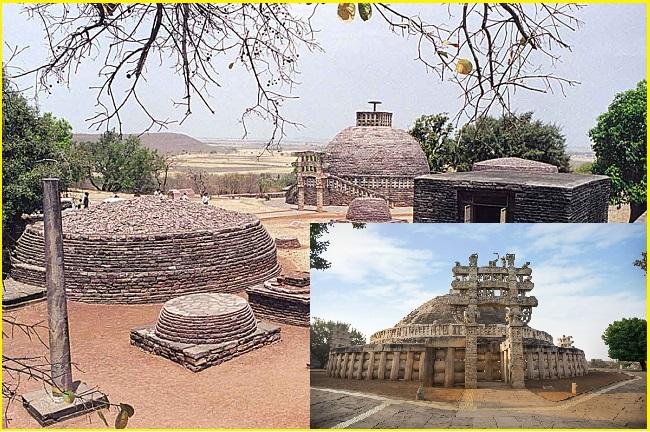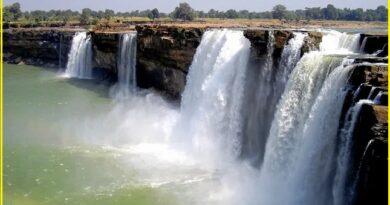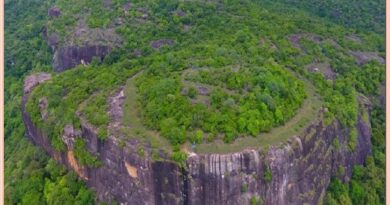The Great Sanchi Stupa India-A great example of Love and War
The Great Sanchi Stupa
Sanchi is a Buddhist complex, famous for its Great Stupa, on a hilltop at Sanchi Town in Raisen District of the State of Madhya Pradesh, India. It is located 45 kilometers northeast of Bhopal, the capital of Madhya Pradesh. The Great Stupa at Sanchi is one of the oldest stone structures in India and an important monument of Buddhist culture. It was originally commissioned by the Mauryan emperor Ashoka the Great in the 3rd century BCE. The site of Sanchi comprises a group of Buddhist monuments including monolithic pillars, palaces, temples, and monasteries.
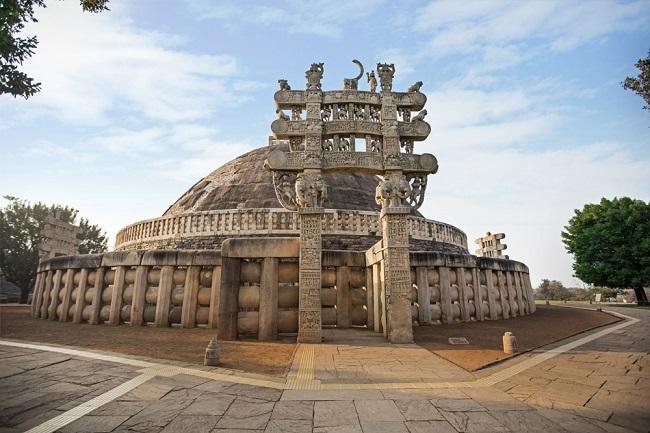
Sanchi is an excellent example of arts and free-standing architecture that tells the history of Buddhism from the 3rd century BCE to the 12th century CE. The Buddhist monuments at Sanchi, located about 10 km from Vidisha, are on a serene and picturesque plateau. It is also considered to be the sacrosanct Cetiyagiri in the Sri Lankan Buddhist chronicles, where Mahindra, the son of Emperor Aśoka, stopped on the way of his journey as a missionary to Sri Lanka. The whole Sanchi stupa and Monument spread in with Vindhyan Sandstone hillock.
History of Sanchi Stupa
The Mauryan Emperor Ashoka, the great, built a stupa at Sanchi after he converted to Buddhism in the 3rd century. Ashoka, wife Devi was the daughter of a merchant of nearby Vidisha and Sanchi was her birthplace as well as the venue of her and Ashoka’s wedding. Ashoka was the third emperor of the Mauryan Dynasty, who is often regarded as cruel. He is also infamous for killing all his brothers to claim the throne. Ashoka’s heart changed after the Kalinga war which is one of the bloodiest battles in Indian history. Ashoka won the battle but he was horrified by seeing the bloodshed during the war and later devoted himself to Buddhism. Ashoka built nearly 84000 stupas to spread the message of Buddha.
Who discovered Sanchi Stupa
In 1818 British Gen. Henry Taylor came upon the site and documented the findings sites. The first scientific excavation of the stupa took place in 1851 under the supervision of Major Alexander Cunningham. The relics of the Buddha’s two chief disciples were found in the ruins of Stupa No.3 at Satdhara (10 km. west of Sanchi) which measured about 12 meters in diameter and was smaller than the Great Stupa.
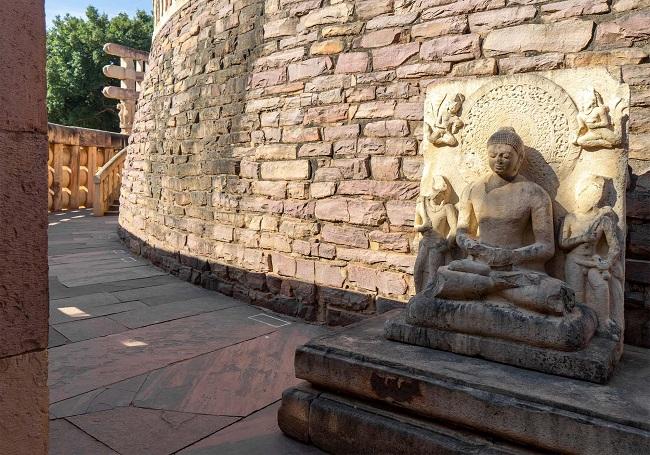
Besides the Sanchi site, they also conducted excavations in the surrounding stupas of Sonari, Satdhara, Bhojpur, and Andher situated 9 km. and 19 km from Sanchi. Here too many precious discoveries were made and most of them were sent to England. Sanchi Stupa is one of the oldest Buddhist monuments in India. Also famous as the Great Stupa or Stupa Number 1, this stone structure is also a UNESCO World Heritage Site. The Monuments at Sanchi are owned by the Government of India and are conserved, protected, maintained, and managed by the Archaeological Survey of India.
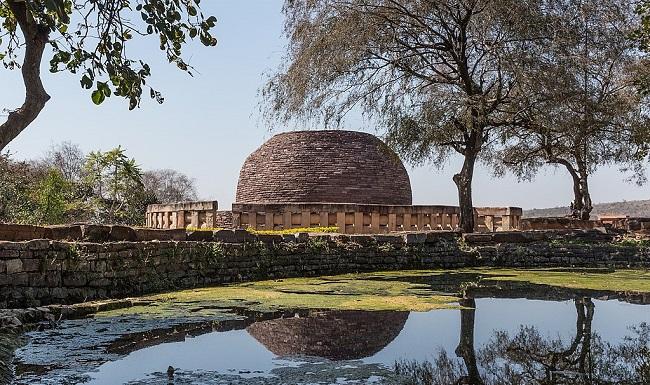
Sanchi Stupa architecture features
The stupas at Sanchi represent the most accomplished form of this type of monument. The hemispherical, egg-shaped dome (Anda), topped with a cubical relic chamber (Harmika), is built on a circular terrace (Medhi). it has one or two ambulatories for the use of (pradakshina paths). Representing a transition from wood structures to stone, the railings (vedika) and the gateways (Torana). The chronological sequence of the four gateways is as follows: Southern, Northern, Eastern, and Western. Devotees donated all these gateways and their names were inscribed on its pillars.
Who Built the famous Sanchi Stupa
Sanchi Stupa is impressive scale today but the original Ashokan stupa (Made by Ashoka the Great in the 3rd century BC) was about half the size and built from large bricks and mud mortar. It’s believed it had raised terraces at the base, was enclosed by a wooden railing and was crowned by a stone umbrella. The stupa was enlarged using local sandstone during the Sunga period, which began about 50 years after Ashoka’s death.
India’s group of Buddhist monuments at Sanchi stupas, temples, and monasteries is unique because of its age and quality. Sanchi plays an important role as an intermediary for the spread of cultures and their peripheral arts throughout the Mauryan Empire, and later during the Sunga, Shatavahana, Kushan, and Gupta dynasties.
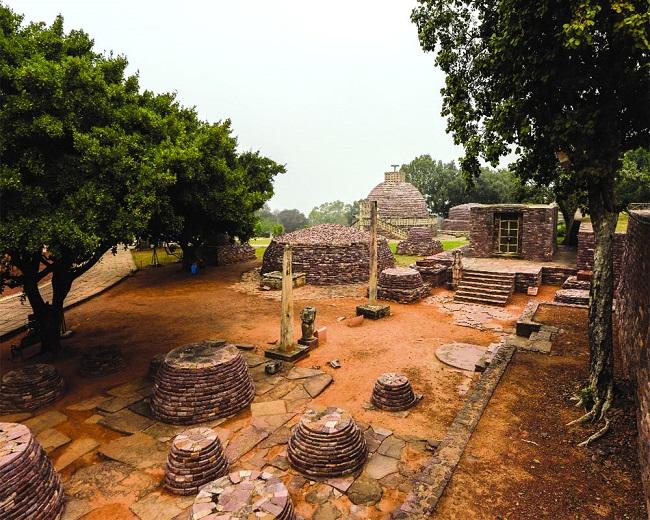
Sanchi is one of the oldest extant Buddhist monuments. Although Buddha never visited the site during any of his former lives or during his earthly existence. The chamber of relics of Stupa 3 contained the remains of Sariputra, a disciple of Shakyamuni (Buddha)who died six months before his master. All the sculpted monolithic pillars, sanctuaries, temples, and viharas have Outstanding Universal Value, atop and along the slopes of the hillock of Sanchi. These elements reflect the mature Buddhist Aniconic art and free-standing architecture.
Also, read- A Hidden Gem of Bundela Architecture- The Orchha Town India
The Sanchi is said to have been a famous religious center from the 3rd century BC to the 13 century AD. The Fame of the Sanchi is declining as a prominent religious site due to the decline of Buddhism in the Indian subcontinent. The gateways at the four cardinal points are the highlights of the structure, with a series of detailed carvings showing Buddhist symbols and important historical and religious scenes. Interestingly, Buddha is always shown in these carvings as a symbol and not as a human. He is represented on the gateways as a horse without a rider, an umbrella above an empty throne, the Bodhi tree, or as footprints.
How to reach Sanchi Stupa
Reaching Sanchi is an easy task. The nearest airport is in Bhopal. A number of prepaid Cabs are available from outside the airport to Sanchi. For those traveling by train, Bhopal and Vidisha railway stations are the Nearest Railhead. From Visdisha, Sanchi is only 15 minutes away.
Source-Mptourism.com, visitworldheritage.com, Whc.UNESCO.org, indianculture.gov.in
